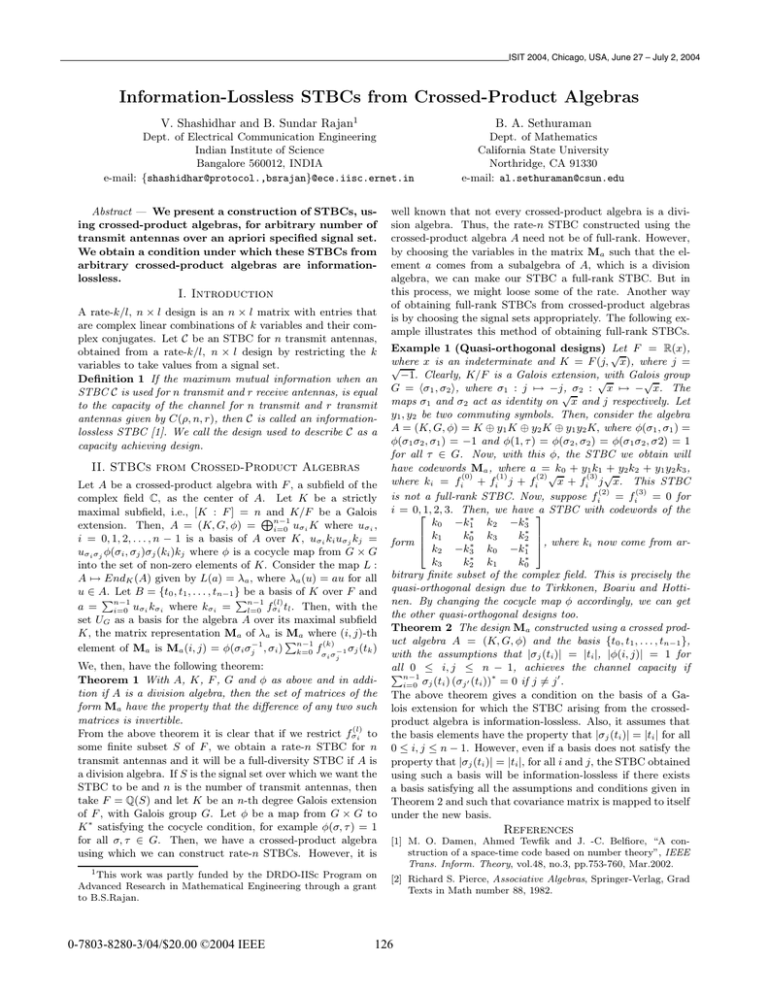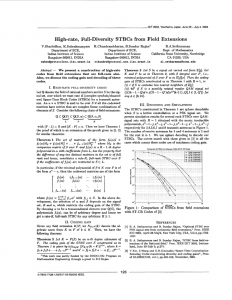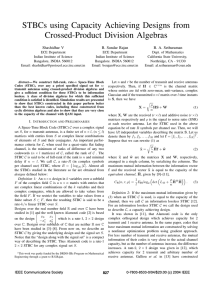Information-Lossless STBCs from Crossed-Product Algebras V. Shashidhar and B. Sundar Rajan
advertisement

ISIT 2004, Chicago, USA, June 27 – July 2, 2004
Information-Lossless STBCs from Crossed-Product Algebras
V. Shashidhar and B. Sundar Rajan1
B. A. Sethuraman
Dept. of Electrical Communication Engineering
Indian Institute of Science
Bangalore 560012, INDIA
e-mail: {shashidhar@protocol.,bsrajan}@ece.iisc.ernet.in
Dept. of Mathematics
California State University
Northridge, CA 91330
e-mail: al.sethuraman@csun.edu
Abstract — We present a construction of STBCs, using crossed-product algebras, for arbitrary number of
transmit antennas over an apriori specified signal set.
We obtain a condition under which these STBCs from
arbitrary crossed-product algebras are informationlossless.
I. Introduction
A rate-k/l, n × l design is an n × l matrix with entries that
are complex linear combinations of k variables and their complex conjugates. Let C be an STBC for n transmit antennas,
obtained from a rate-k/l, n × l design by restricting the k
variables to take values from a signal set.
Definition 1 If the maximum mutual information when an
STBC C is used for n transmit and r receive antennas, is equal
to the capacity of the channel for n transmit and r transmit
antennas given by C(ρ, n, r), then C is called an informationlossless STBC [1]. We call the design used to describe C as a
capacity achieving design.
II. STBCs from Crossed-Product Algebras
Let A be a crossed-product algebra with F , a subfield of the
complex field C, as the center of A. Let K be a strictly
maximal subfield, i.e., [K : F ] = nL
and K/F be a Galois
n−1
extension. Then, A = (K, G, φ) =
i=0 uσi K where uσi ,
i = 0, 1, 2, . . . , n − 1 is a basis of A over K, uσi ki uσj kj =
uσi σj φ(σi , σj )σj (ki )kj where φ is a cocycle map from G × G
into the set of non-zero elements of K. Consider the map L :
A → EndK (A) given by L(a) = λa , where λa (u) = au for all
u ∈ A. Let B = {t0 , t1 , . . . , tn−1 } be a basis of K over F and
Pn−1
Pn−1 (l)
a =
i=0 uσi kσi where kσi =
l=0 fσi tl . Then, with the
set UG as a basis for the algebra A over its maximal subfield
K, the matrix representation Ma of λa is Ma where (i, j)-th
P
(k)
element of Ma is Ma (i, j) = φ(σi σj−1 , σi ) n−1
−1 σj (tk )
k=0 f
σi σj
We, then, have the following theorem:
Theorem 1 With A, K, F , G and φ as above and in addition if A is a division algebra, then the set of matrices of the
form Ma have the property that the difference of any two such
matrices is invertible.
(l)
From the above theorem it is clear that if we restrict fσi to
some finite subset S of F , we obtain a rate-n STBC for n
transmit antennas and it will be a full-diversity STBC if A is
a division algebra. If S is the signal set over which we want the
STBC to be and n is the number of transmit antennas, then
take F = Q(S) and let K be an n-th degree Galois extension
of F , with Galois group G. Let φ be a map from G × G to
K ∗ satisfying the cocycle condition, for example φ(σ, τ ) = 1
for all σ, τ ∈ G. Then, we have a crossed-product algebra
using which we can construct rate-n STBCs. However, it is
1 This work was partly funded by the DRDO-IISc Program on
Advanced Research in Mathematical Engineering through a grant
to B.S.Rajan.
,(((
well known that not every crossed-product algebra is a division algebra. Thus, the rate-n STBC constructed using the
crossed-product algebra A need not be of full-rank. However,
by choosing the variables in the matrix Ma such that the element a comes from a subalgebra of A, which is a division
algebra, we can make our STBC a full-rank STBC. But in
this process, we might loose some of the rate. Another way
of obtaining full-rank STBCs from crossed-product algebras
is by choosing the signal sets appropriately. The following example illustrates this method of obtaining full-rank STBCs.
Example 1 (Quasi-orthogonal designs) √
Let F = R(x),
where x is an indeterminate and K = F (j, x), where j =
√
−1. Clearly, K/F is a Galois extension,√with Galois
√ group
G = σ1 , σ2 , where σ1 : j → −j,√ σ2 : x → − x. The
maps σ1 and σ2 act as identity on x and j respectively. Let
y1 , y2 be two commuting symbols. Then, consider the algebra
A = (K, G, φ) = K ⊕ y1 K ⊕ y2 K ⊕ y1 y2 K, where φ(σ1 , σ1 ) =
φ(σ1 σ2 , σ1 ) = −1 and φ(1, τ ) = φ(σ2 , σ2 ) = φ(σ1 σ2 , σ2) = 1
for all τ ∈ G. Now, with this φ, the STBC we obtain will
+ y 2 k2 + y 1 y 2 k3 ,
have codewords Ma , where a =√k0 + y1 k1 √
(3)
(0)
(1)
(2)
x + fi j x. This STBC
where ki = fi + fi j + fi
(2)
(3)
is not a full-rank STBC. Now, suppose fi = fi = 0 for
i = 0,21, 2, 3. Then, we have 3a STBC with codewords of the
k0 −k1∗ k2 −k3∗
6 k1
k0∗ k3
k2∗ 7
7
form 6
4 k2 −k3∗ k0 −k1∗ 5, where ki now come from ar∗
∗
k3
k2 k1
k0
bitrary finite subset of the complex field. This is precisely the
quasi-orthogonal design due to Tirkkonen, Boariu and Hottinen. By changing the cocycle map φ accordingly, we can get
the other quasi-orthogonal designs too.
Theorem 2 The design Ma constructed using a crossed product algebra A = (K, G, φ) and the basis {t0 , t1 , . . . , tn−1 },
with the assumptions that |σj (ti )| = |ti |, |φ(i, j)| = 1 for
all 0 ≤ i, j ≤ n − 1, achieves the channel capacity if
P
n−1
∗
i=0 σj (ti ) (σj (ti )) = 0 if j = j .
The above theorem gives a condition on the basis of a Galois extension for which the STBC arising from the crossedproduct algebra is information-lossless. Also, it assumes that
the basis elements have the property that |σj (ti )| = |ti | for all
0 ≤ i, j ≤ n − 1. However, even if a basis does not satisfy the
property that |σj (ti )| = |ti |, for all i and j, the STBC obtained
using such a basis will be information-lossless if there exists
a basis satisfying all the assumptions and conditions given in
Theorem 2 and such that covariance matrix is mapped to itself
under the new basis.
References
[1] M. O. Damen, Ahmed Tewfik and J. -C. Belfiore, “A construction of a space-time code based on number theory”, IEEE
Trans. Inform. Theory, vol.48, no.3, pp.753-760, Mar.2002.
[2] Richard S. Pierce, Associative Algebras, Springer-Verlag, Grad
Texts in Math number 88, 1982.


